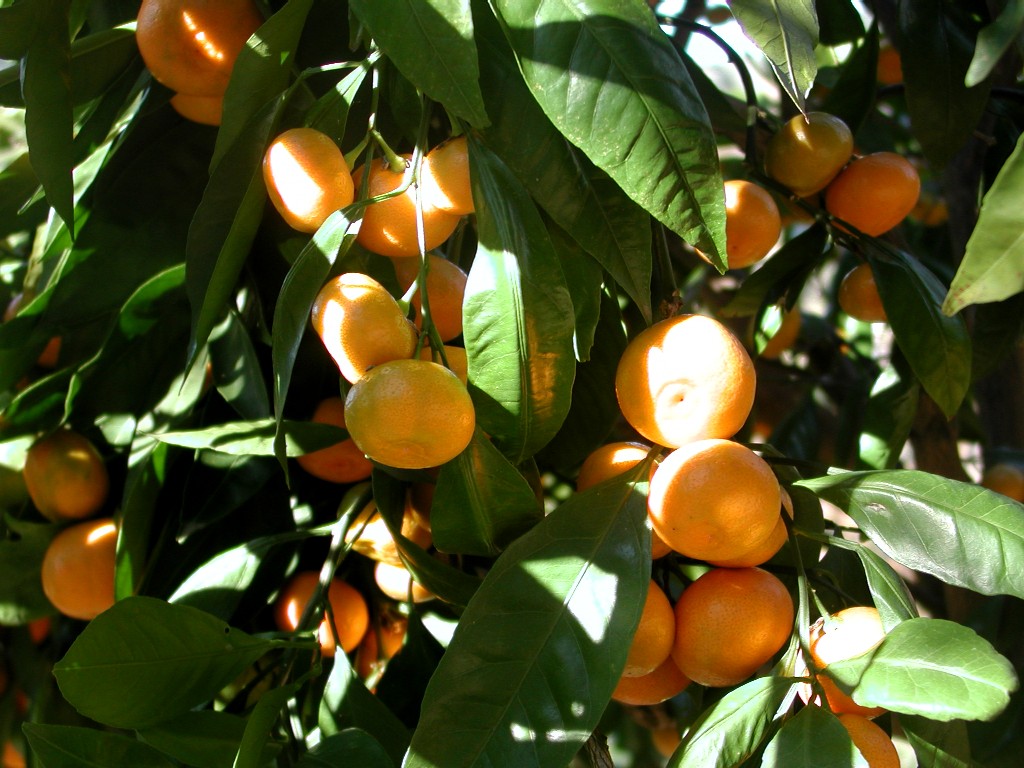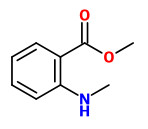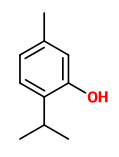Citrus reticulata Blanco - syn. Citrus deliciosa Ten., Citrus nobilis Lour. - Rutaceae
mandarin, mandarine, Mandarine
Mandarin is possibly a native of south east China and or south Japan. It is extensively cultivated in East- and Southeast Asia, Australia and South Europe (introduced at the beginning of the nineteenth century).
„Specifically reddish-orange mandarin cultivars can be marketed as tangerines, but this is not a botanical classification.“ http://en.wikipedia.org/wiki/Mandarin_orange
A clementine (Citrus ×clementina = Citrus clementina hort. ex Tanaka; Citrus reticulata ‘Clementine’) is a hybrid between a mandarin and a sweet orange (so named in 1902). http://en.wikipedia.org/wiki/Clementine
Mandarin flower scent: Main flower volatiles (cv.Ponkan) were linalool (46-50%), β-pinene (6.5-9.2%), thymol (4-5%), indole (2-5%), benzyl nitrile (tr-4.6%), α-terpineol (1.9-3.8%), β-farnesene (2.2-3.5%), (E)-β-ocimene (2.1-3.0%), 8-heptadecene (1.7-2.6%), δ-cadinene (1.6-2.1%), geraniol (tr-2.4%), cis-β-terpineol (1.0-2%), γ-terpinene (1.4-1.9%), thymol methylether (1.0-1.9%), myrcene (1.1-1.4%), limonene (1.0-1.4%), δ-elemene (tr-1.3%), γ-elemene (tr-1.1%), and phenylacetaldehyde (tr-1.0%).
[Azam, M., Song, M., Fan, F., Zhang, B., Xu, Y., Xu, C., & Chen, K. (2013). Comparative analysis of flower volatiles from nine Citrus at three blooming stages. International journal of molecular sciences, 14(11), 22346-22367] http://www.mdpi.com/1422-0067/14/11/22346/htm
Mandarin peel oils are dominated by limonene (55-96%), with several other hydrocarbons like ɣ-terpinene (trace-19%), p-cymene (trace-12%), myrcene (0.7-24%), α-pinene (0.2-2%), ß-pinene (trace-14%), sabinene (0.1-8%), and ß-phellandrene (0.2-0.8%) as minor components.
Mandarin leaf oils (petitgrain oils) show an important chemical variability with the occurance of sabinene (0.1-57%), ɣ-terpinene (0.1-67%), linalool (trace-69%), and methyl N-methylanthranilate (0-78%). For most samples, best represented components were sabinene, ɣ-terpinene, myrcene, limonene, and (E)-ß-ocimene. For other samples, the oxygenated fraction dominated with linalool, thymol, or methyl N-methylanthranilate.
[Chemical variability of peel and leaf essential oils of 15 species of mandarins., Lota, M. L., de Rocca Serra, D., Tomi, F., Casanova, J., Biochemical Systematics and Ecology, 29(1), 2001, 77-104]
Whereas the extract (CH2Cl2) of mandarin (Citrus deliciosa Ten.) peel oil showed limonene (58.9%) and ɣ-terpinene (21.6%) as main constituents, tangerine (Citrus reticulata Blanco 'Dancy') peel oil extract had limonene (95.2%), but no ɣ-terpinene.
The main group of organoleptically interesting compounds from solvent extracts of fresh mandarin and tangerine peel were unsaturated aldehydes including decenals, decadienals, decatrienals, dodecenals and dodecadienals. Olfactorly interesting trace components were (1,3Z,5Z)-undecatriene and two undecatetraenes, 3-butylpyridine, indole, alkylpyrazines, and diethyl disulfide e.g.
„In mandarin, the characteristic tonality was due to a combination of the monoterpenes with α-sinensal, thymol and methyl N-methyl anthranilate, but, as in tangerine, fatty, aldehydic notes were overwelming.“
[Naef, Regula, and Alain Velluz. „Volatile constituents in extracts of mandarin and tangerine peel.“ Journal of Essential Oil Research 13.3 (2001): 154-157]
„Gas chromatography–olfactometry (GC–O), gas chromatography–mass spectrometry (GC–MS) and preparative column chromatography were used to identify the key odorants present in laboratory-extracted clementine oil from Spain. Almost 50 odorants were identified using GC–O, many of which were unsaturated aldehydes with high odour spectrum values (OSV). α- and β-sinensal, trans-4,5-epoxy-(E)-2-decanal, (E,Z)-2,6-dodecadienal and linalool were found to dominate clementine oil aroma. Enrichment of the oxygenates using preparative column chromatography provided further identification of a total of 50 aldehydes, not all of which were present in the oil at concentrations high enough to produce a response using GC–O. Aldehydes contributed approximately 80% of the total aroma of clementine oil. New odorants not previously reported in clementine oil include many unsaturated aldehydes, trans-4,5-epoxy-(E)-2-decenal, trans-4,5-epoxy-(E)-2-dodecenal, 4-hydroxy-2,5-dimethyl-3(2H)-furanone (furaneol), 3-hydroxy-4,5-dimethyl-3(2H)-furanone (sotolon) and 1,8-cineole. No single odorant emerged as being characteristic of clementine oil aroma.“
[Chisholm, Mary G., Jason A. Jell, and Dean M. Cass Jr. „Characterization of the major odorants found in the peel oil of Citrus reticulata Blanco cv. Clementine using gas chromatography–olfactometry.“ Flavour and fragrance journal 18.4 (2003): 275-281]
Clementine peel oil odour is more orange-like than mandarin-like, with the highest flavour dilution factors determined for linalool (flowery), (E,E)-deca-2,4-dienal (fatty) and winelactone (sweet), followed by α-pinene (pinetree-like), myrcene (geranium leaf) and octanal (citrus).
[Evaluation of the most odour-active compounds in the peel oil of clementines (Citrus reticulata Blanco cv. clementine)., Buettner, A., Mestres, M., Fischer, A., Guasch, J., Schieberle, P., European Food Research and Technology, 216(1), 2003, 11-14]
„(3E,5Z)-undeca-1,3,5-triene also occurs in olfactorly significant amounts in, for example, angelica root oil, lavender oil, celery herb oil, the scent of fresh pineapple, mandarin, peppermint, and many Coryanthes species.“
[Meaningful Scents around the World, R.Kaiser, 2006, 58; R.Kaiser internal Givaudan files]
„Examination of selected highly odoured constituents of orange and mandarin oils shows the concentration and threshold of these constituents. If the concentration in ppm is divided by its threshold (also in ppm), the percentage importance of these constituents reveals that in orange oil the major components responsible for the odour character of this oil are octanal, decanal, linalool, ß-sinensal, α-sinensal, and nonanal. Similarly, α-sinensal, octanal, decanal, methyl N-methylanthranilate, nonanal and linalool are the major components responsible for the odour of mandarine oil.“
[Swift, Karl AD, ed. Advances in flavours and fragrances: From the sensation to the synthesis. Royal Society of Chemistry, 2007, 79-80]
Main differences found between the compositions of cold-pressed mandarin peel oil from Spain (red oil) and from Brazil (green oil) were: (Red/Green) Limonene (95.9/69.9%), ɣ-terpinene (0/20.0%), α-pinene (0.5/2.0%), terpinolene (0/0.9%), decanal (0.13/0.30%), methyl N-methylanthranilate (0/0.43%), and sinensal (0/0.30%).
[Danielski, Leandro, et al. „Deterpenation of mandarin (Citrus reticulata) peel oils by means of countercurrent multistage extraction and adsorption/desorption with supercritical CO2.“ The Journal of Supercritical Fluids 44.3 (2008): 315-324]
The volatile oil of mandarine peel contains mainly limonene (80-94%) and ɣ-terpinene (3-17%). „Unlike other citrus oils, mandarin oil and the cold-pressed oils of tangerine and clementine contain considerable amounts of methyl N-methylanthranilate (0.85%). If mixed in the right proportions with thymol should … elicit typical notes recalling mandarin oil. If ɣ-terpinene and ß-pinene are added to this mixture, it becomes even more natural… It seems that the presence of (+)-α-thujene (0.5%) is typical for mandarin oil, and α-sinensal (0.2%) is also most abundant in mandarin oil.“
[Scent and Chemistry, Günther Ohloff, Wilhelm Pickenhagen, Philip Kraft, Wiley-VCH, 2012, 223-227]
By vacuum fractional distillation of the essential oil, olfactory important traces compounds may be concentrated, like methyl-N-methyl anthranilate (mass fraction of 0.6% in the raw oil to 15.3%) and α-sinensal (raw oil 0.4% to 10.9%). Limonene was lowered from 70.7% to 21.8%.
[Silvestre, W. P., et al. „Fractionating of green mandarin (Citrus deliciosa Tenore) essential oil by vacuum fractional distillation.“ Journal of Food Engineering 178 (2016): 90-94]

Mandarin tree, Berkeley Botanical Garden, photo by Allen Timothy Chang
CC BY-SA 3.0, Author: Guety Wikimedia Commons





